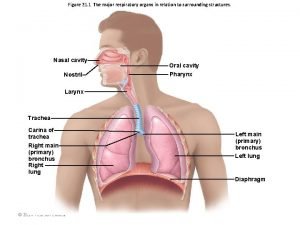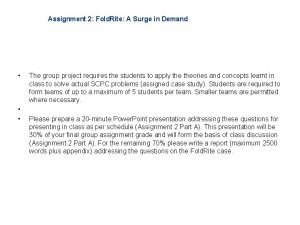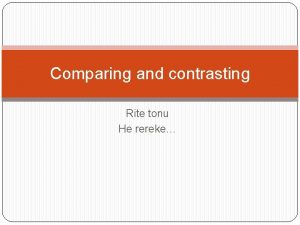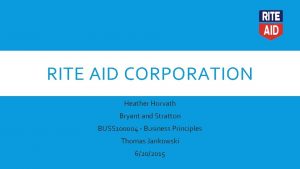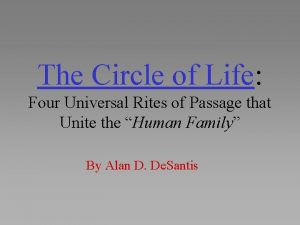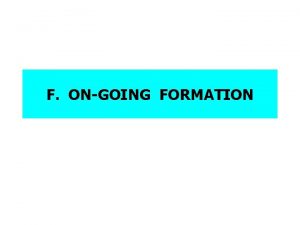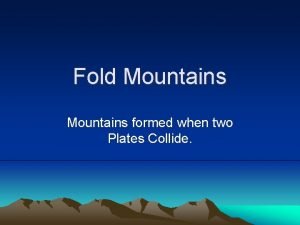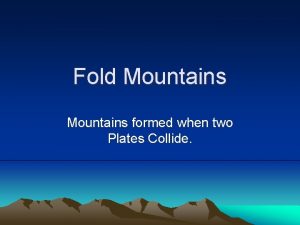Assignment 2 Fold Rite A Surge in Demand













- Slides: 13

Assignment 2: Fold. Rite: A Surge in Demand • • • The group project requires the students to apply theories and concepts learnt in class to solve actual SCPC problems (assigned case study). Students are required to form teams of up to a maximum of 5 students per team. Smaller teams are permitted where necessary. Please prepare a 20 -minute Power. Point presentation addressing these questions for presenting in class as per schedule (Assignment 2 Part A). This presentation will be 30% of your final group assignment grade and will form the basis of class discussion (Assignment 2 Part A). For the remaining 70% please write a report (maximum 2500 words plus appendix) addressing the questions on the Fold. Rite case.

Fold. Rite: Please develop a capacity plan for Fold. Rite. What recommendations would you make to Martin Kelsey in Feb. 2010? Which option(s) (or combinations of options) should they pursue to meet the surge in demand? What are their specific quantitative (i. e. , financial performance) or qualitative implications? Below some steps that you could use a guideline for your analysis: The steps involved in planning include: a)Calculating available skilled and unskilled workers b)Determining the labor required to fulfill demand c)Determining the total cost of fulfilling demand for each option by adding the cost of: a)Overtime b)Use of subcontractors c)Hiring and training workers d)Cost of design change e)Cost of carrying inventory Additionally, the inventory level and production shortfalls over the 6 month for each option need to be determined to ensure ontime delivery

The required format for the layout of the report is as follows: 1) Cover page as per UCD Distance Learning Unit specifications 2) Executive Summary -In a single paragraph, summarise the contents of the entire report. This should be written last when the rest of the report is completed, so that you know what you are summarizing. 3) Introduction to the selected project -Briefly give an introduction to the case you are analysing. - Outline your plan to analyse the case 1)4) Analysis of the case 2) -Using theory in the topic, analyse the case 3) -You should devote most of the effort to applying theory to answer the case study questions. 4) 5)5) Discussion and Conclusions 6) - In this section, you discuss your answers 7) -- Identify the key learning points in the case and what your group learned from undertaking 8) the assignment. 9) 10)6) References 11) -All third party material used in the report must be listed using a formal referencing system 12) such as the Harvard system. This must be correctly cited where used in the body of the report. 13)

Case Study: Fold. Rite Furniture Co. : Planning to meet a surge in demand What recommendations would you make to Martin Kelsey in Feb. 2010? Be specific and provide support for your recommendations. These recommendations should be suitable for presentation to upper management at Fold. Rite. 4

Detailed analysis of financial impact of selecting various options Environment and overview: • FR revenue comes from folding table (42%), stackable chair (34%) and new folding chair (24%) • Large increase in demand is expected over next 6 month • Business is seasonal – March-August period accounts for 59 -60% of annual demand for folding tables and stackable chairs, and 70% for folding chairs • FR is strapped for cash due to general credit crunch and is unwilling to produce any significant quantity for inventory

Detailed analysis of financial impact of selecting various options Manufacturing Process: • Manufacturing at FR is simple and solely depends on skilled and unskilled, largely interchangeable, labor input • The tasks that generate the components proceed simultaneously: metal fabrication, injection molding of seats for foldable chairs, and laminating and thermal molding of stackable chair cover – Sub-assembly of these components follows – Final assembly takes place on a moving conveyer • All production planning is highly centralized – 2 -week inventory of production – WIP inventory are kept at an absolute minimum

Detailed analysis of financial impact of selecting various options Analysis of Process and Planning: Assumptions: • Productivity and yields remain the same when the production exceeds planned capacity • Company builds up a standard 2 weeks (8 days) of inventory prior to March • To minimize costs, inventory levels could be allowed to fall somewhat below the target during peak • Level and balanced production for all products • Inventory carrying cost is equal to the cost of financing (1%/month) of finished goods at cost • Average monthly inventory for each product is ½ of the total for the month

Detailed analysis of financial impact of selecting various options The steps involved in planning include: a) Calculating available skilled and unskilled workers b) Determining the labor required to fulfill demand c) Determining the total cost of fulfilling demand for each option by adding the cost of: a) b) c) d) e) Overtime Use of subcontractors Hiring and training workers Cost of design change Cost of carrying inventory Additionally, the inventory level and production shortfalls over the 6 month for each option need to be determined to ensure on-time delivery

Step 1&2: Calculating available number of workers & determining required workers Cloud. Chair Al. Strong Green. Comfort Production days Required skilled hours March 45. 000 27. 000 22. 680 18 12. 815 April 73. 800 29. 700 25. 200 18 15. 006 May 65. 250 28. 500 22. 500 15 13. 821 June 79. 200 36. 000 27. 900 18 17. 226 July 86. 400 32. 400 25. 200 18 16. 055 August 67. 150 29. 750 21. 250 17 13. 883 Available skilled hours 13. 140 10. 950 13. 140 12. 410 325 -1. 866 -2. 871 -4. 086 -2. 915 -1. 473 Needed Skilled workers -2 10 19 23 16 9 Required unskilled hours 32. 703 39. 947 36. 539 45. 363 43. 263 36. 774 Available unskilled hours 33. 480 27. 900 33. 480 31. 620 777 -6. 467 -8. 639 -11. 883 -9. 783 -5. 154 -4 36 58 Excess (shortfall) Needed unskilled workers 66 54 30

Step 3: Examining the options Options: 1. Overtime 2. Subcontracting 3. Hiring (a) Early hiring strategy (b) Hiring delayed to April 4. Hiring & Training 5. Change in Design (a) Hire all workers needed starting in March 1, and use overtime for 6 workers in this month (b) Hire all needed workers in April (c) Hire unskilled workers to train in March and start extra production in April

Shortages, Overages, and Inventory Levels for Various Options Shortage/Overage, Options 3, 5 a Mar Apr May Cloud. Chair 27. 138 -1. 662 Al. Strong 4. 734 2. 034 Green. Comfort 2. 369 -151 Level of Inventory, Options 3 a, 5 a Mar Apr May Cloud. Chair 48. 110 46. 448 Al. Strong 17. 010 19. 044 Green. Comfort 12. 512 12. 362 Shortage/Overage, Options 3 b, 4, 5 b, 5 c Mar Apr May Cloud. Chair 2. 185 3. 561 Al. Strong 622 2. 894 Green. Comfort 141 316 Level of Inventory, Options 3 b, 4, 5 b, 5 c Mar Apr May Cloud. Chair 23. 156 26. 718 Al. Strong 12. 899 15. 793 Green. Comfort 10. 284 10. 600 Standard Inventory level Mar Apr May Cloud. Chair 20. 971 Al. Strong 12. 277 Green. Comfort 10. 143 Jun Jul Aug -5. 135 -2. 055 -1. 625 Jun 41. 314 16. 989 10. 736 Jun -782 -1. 338 -1. 237 Jun 25. 935 14. 455 9. 363 Jun 20. 971 12. 277 10. 143 -7. 062 -4. 266 -2. 851 Jul 34. 252 12. 722 7. 886 Jul -1. 839 -3. 406 -2. 384 Jul 24. 097 11. 049 6. 979 Jul 20. 971 12. 277 10. 143 -14. 262 -666 -151 981 221 2. 408 Aug 19. 990 12. 056 7. 735 20. 971 12. 277 10. 143 Aug -9. 039 194 316 5. 913 1. 033 2. 848 Aug 15. 058 11. 243 7. 295 20. 971 12. 277 10. 143 Aug 20. 971 12. 277 10. 143 20. 971 12. 277 10. 143

Results Option 1 Option 2 Option 3 a Option 3 b Option 4 Option 5 a Option 5 b Option 5 c Additional Labor Costs $366. 513 $0 $0 -($63. 305) -($64. 196) Hiring & Loss of Design Change Subcontract productivity Training $0 $0 $0 $119. 674 $4. 216 $0 $0 $0 $45. 344 $0 $0 $0 $55. 337 $0 $0 $0 $24. 531 $25. 344 $15. 000 $0 $42. 954 $0 $15. 000 $0 $52. 947 $0 $15. 000 $0 $22. 141 $25. 344 Inventory $0 $0 $12. 611 $2. 974 Total $366. 513 $123. 890 $57. 955 $58. 311 $52. 850 $7. 260 $6. 725 $1. 263

Learning objectives/outcomes • Explore various manufacturing options to deal a projected short term surge in demand • Use simple quantitative/financial models in the decision process • Understand the risks associated with these options • Assess the impact of soft attributes such as workers loyalty, productivity, etc.


